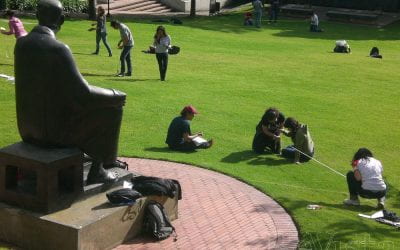The MECESUP Program in Chile
15 Years Supporting Higher Education Quality Improvement

New engineering facility at the Universidad de Magallanes (in Punta Arenas, 3,860 km from Arica; 70 percent of MECESUP resources were allocated to regional institutions. Photo courtesy of Ricardo Reich.
As the rain poured down on a gloomy day in Concepción that June in 1997, I received a rather unexpected phone call from the Ministry of Education. I had just ended an eight-year stretch as vice-president of research at Universidad de Concepción in the south of Chile and was thinking about how to restart my academic career in chemical engineering. On the other end of the phone was the Head of Higher Education, inviting me to implement a new Higher Education Quality Improvement Program, sponsored by the World Bank and christened MECESUP (Mejoramiento de la Equidad y Calidad en la Educación Superior). The invitation was surprising, in part because Chile is so centralized in the capital, Santiago, 270 miles away. I saw this honor as a great opportunity to contribute to higher education development in our country. So I accepted, and now have led the MECESUP Program under four different administrations.
Back in 1988, higher education funding was mainly allocated on the basis of historical criteria, with no public accountability. By 1990, an Institutional Development Fund had begun operations; however, accountability still wasn’t a requirement. Only research funds from the National Research Council (CONICYT) were allocated on a competitive basis and involved a certain degree of evaluation.
At that time, most universities took neither strategic nor long-term planning into consideration. Performance information was inconsistent and not readily available. Not only were retention and graduation rates absent—they were often taboo to discuss. And, of course, no one wanted to mention that most Chilean universities fell below international standards.
Today, MECESUP aims to provide that quality control. Housed in the Department of Institutional Financing at the Division of Higher Education, it has a much more complex structure and scope than when it was first conceived. When MECESUP started, the Chilean system was—and still is—deregulated and of uneven quality. Altough back then no quality assurance existed on a national scale, self-assessment with external peer reviewing had begun in 1990 for university licensing—after which universities could make independent decisions about their functioning without supervision from government authorities. In 1993, peer reviewing at the Universidad de Concepción and Universidad de Chile also began in order to improve institutional academic quality. Undoubtedly, this was the dawn of higher education quality assurance in Chile.
When the government decided, in collaboration with the World Bank, to set up MECESUP, it took place in the midst of a marked increase in university enrollment (from 250,000 students in 1990 to 1,070,000 in 2011). The Program funded the overall improvement of academic infrastructure at the 25 “traditional” institutions of the Council of Chilean Universities (CRUCH)—private and public universities with partial state funding nationwide. This resulted in a significant increase in equity of access to quality in higher education institutions throughout the country. The MECESUP Program also factored in a capacity-building component, the design and pilot implementation of a voluntary accreditation process for degree programs, the design and implementation of a Competitive Innovation Fund that would replace the 1990 Institutional Development Fund and the introduction of accountability measures. The total investment was US$245 million over five years.
Phase I. Recovery of Academic Infrastructure and Quality Assessment
The first phase of implementation sought to both restore and improve higher education academic infrastructure, to support institutional capacity building and introduce accountability. Eligibility was limited to CRUCH universities and vocational institutions.
The accreditation system was designed and then put into practice bit by bit, learning from the experiences of the licensing processes, as well as leading international experiences. The CRUCH universities strongly supported the process from the beginning. Later, in 2005, the process was extended to institutional accreditation. Universities had to learn to assess themselves and to submit quality improvement proposals to the Competitive Fund. Eligibility and selection criteria were laid out clearly, with an emphasis on the stimulation of innovation and the development of new solutions. This process ensured strong ownership of reforms at a decentralized level and enabled institutions to identify weaknesses and appropriate solutions. Funding incentives for quality improvement, in turn, provided opportunities for corrective actions. Today, institutional and program accreditation is implemented by the National Accreditation Commission, which legally started operating in 2007.
The Competitive Fund began to support enhanced teacher and student learning, doctoral program development and management capacity building in universities. This included library modernization, more spaces for student learning, information access and management, integration of information technology into programs for better learning, new laboratory equipment and technologies, modern lecture rooms, use of multimedia, new science instrumentation and doctoral scholarships. In Phase I, the general hypothesis was that investment in academic infrastructure would improve teaching and learning and, therefore, employability to graduates.
As an institutional capacity building instrument, the Competitive Fund was the first organization in Chile to introduce accountability measures that led to long-term and strategic planning and management through well-designed proposals and monitoring and evaluation of results and impact.
This Fund, after five years of convocations and competitions, supported 400 projects with a grant investment averaging US$550,000. Regional universities outside Santiago received 70 percent of the total amount for undergraduate support. Improvement and development of new doctoral programs accounted for 20 percent of the investments, and the remaining 10 percent for vocational education to improve teaching and learning in technological areas needed by the productive sector.
Phase II. Performance-based Pilot Program
The next stage was to allocate funds to institutions according to the results of their management. Eligibility was extended to new private universities in a limited number of specific areas related to teacher training and doctoral programs.
With the implementation of the MECESUP Program, the Chilean higher education system had made significant changes and improvements. However, the Competitive Fund—the sole incremental funding allocation mechanism—had showed some weaknesses. One of these was the difficulty of addressing complex institutional issues such as strategic planning, extent of impact on student learning and employability, and overall management improvement.
In 2005, as a result of lessons learned during implementation, the government decided to complement the Competitive Fund with a pilot program that would target changes at the institutional level. For this second phase, it signed another agreement with the World Bank (Loan 7317-CH). The level of funding was maintained at US$50 million per year.
The former Competitive Fund became the Academic Innovation Fund. Between 2006 and 2008, it funded 371 projects. Strong emphasis was placed on staff development and doctoral programs, moving away from a teacher-centered undergraduate educational model to a student-centered learning one, continuing support of innovation in academia, and improving academic management through institutional research and academic staff training.
For the first time, pilot performance-based agreements had been negotiated and agreed upon with the Universidad de Tarapacá (in Arica), the Universidad del Bío-Bío (in Concepción), the Universidad de La Frontera (in Temuco) and the Universidad de Chile (in Santiago). The agreements, with a budget of US$20 million, were signed for a three-year period in 2007. After a successful international mid-term evaluation in 2010, the agreements finally ended during the first semester of 2011 with notable outcomes. The international evaluation recommended the expansion of the program to reach more institutions and produce faster and deeper change.
Also, in 2008, special resources (US$72 million) were designated for the improvement of humanities, arts and social sciences at the Universidad de Chile and five other state universities. These incremental funds were negotiated and allocated under the same performance-based funding model; the institutional improvement plans are presently being implemented.
Phase III. Performance-based Agreement Expansion
Beginning in 2010, the current government has scaled up the performance-based agreement pilot and financing model to a new program to be implemented during 2012-2016. The plan is to allocate a “set-aside” fund of about US$90 million per year to provide incentives for faster institutional changes in areas of specific public policy priorities.
The main focus will be the improvement of teacher training institutions and programs, the re-design of the undergraduate curriculum, the improvement of doctoral programs with a focus on internationalization and innovation, the upgrade of the vocational education sector and the synergy of regional higher education institutions with their stakeholders. All Chilean higher education institutions that have been granted full institutional accreditation will be eligible.
This program will form part of a new agreement with the World Bank for the support of Tertiary Education in Chile, to take effect in the second half of 2012. The new loan—and significant state funding—will support performance goals, the adoption of best international practices, consulting costs, and quality assurance. The impact of these important national and institutional efforts will hopefully be felt in positive results during the next five to ten years. Chile urgently needs positive outcomes in education and innovation in order to increase its global competitiveness.
Fall 2012, Volume XII, Number 1
Ricardo Reich is a chemical engineer with a PhD from the Georgia Institute of Technology. He has spent his entire academic career at Universidad de Concepción in Chile, where he also served as Vice-President of Research for more than 10 years. At the Chilean Ministry of Education he assisted with the initial design and implementation of the MECESUP Program. Today he acts as Head of the Department of Institutional Financing in Higher Education. He can be contacted at ricardo.reich@mineduc.cl. Specific information on the performance-based financing model used in Chile, lessons learned during its implementation and two specific publications (in English) can be found on the MECESUP website http://www.mecesup.cl or by contacting the author.
Related Articles
First Take: Innovating Universities
The next decade of higher education in Latin America will have a very important influence in the future of Latin America itself. It is in universities that most of the public and private leadership will be educated. It is in universities that many of the ideas about how to…
Venezuela’s Student Movement
Students in Venezuela have an 84 percent confidence rating in polls among the public, higher even than the Church or banks, according to www.datanalisis.com. Our struggle for democracy sometimes feels like the struggle of David against Goliath. However, we insist on…
Chile’s Student Protests
Less than a decade ago, academics and journalists almost always referred to Chile as a “model” country, praising its economy, political transition and democracy. Always a simplistic characterization, it nonetheless stuck for many years, until the unexpected 2011 explosion…




